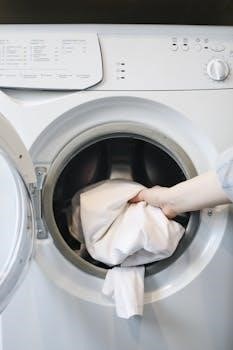Indesit Condenser Tumble Dryer Manual⁚ A Comprehensive Guide
Welcome to your comprehensive guide! This resource offers valuable information on operating and maintaining your Indesit condenser tumble dryer, ensuring optimal performance and longevity. Discover essential tips and guidance for efficient drying.
Understanding Your Indesit Condenser Dryer
Before diving into operation, understanding the basics of your Indesit condenser dryer is crucial. Unlike vented dryers, condenser models don’t require external venting. Instead, they collect moisture from your clothes into a container that you’ll need to empty after each cycle. This makes them more versatile in terms of placement within your home.
Your Indesit dryer is designed with various features to optimize drying performance and protect your garments. Familiarize yourself with the control panel, which offers different drying programs tailored to specific fabric types and load sizes. Understanding these settings will help you achieve the best results while minimizing energy consumption.
Regular maintenance is key to keeping your condenser dryer running smoothly. Cleaning the fluff filter after every cycle is essential to maintain airflow and prevent overheating. Additionally, periodic cleaning of the condenser unit itself will help prevent buildup and ensure efficient moisture extraction. By following these guidelines, you can extend the lifespan of your appliance and enjoy consistently dry clothes.

Installation and Setup
Proper installation ensures safe and efficient operation. This section guides you through placing your dryer, connecting it electrically, and essential pre-use checks. Follow these steps for optimal performance.
Where to Place Your Dryer
Selecting the right location for your Indesit condenser tumble dryer is crucial for its efficient operation and your safety. The dryer should be placed where there is adequate air circulation to prevent overheating. Avoid confining the dryer in a small, unventilated space.
Ensure the area is free from dust and debris, particularly beneath the dryer. This helps maintain proper airflow. The appliance must be installed with its rear surface against a wall for stability and to prevent movement during operation.
While installing the dryer in a cupboard is not recommended, it should never be placed behind a lockable door or a sliding door. If next to furniture units, ensure adequate space to allow proper ventilation.
If you consider stacking your Indesit dryer on top of an Indesit washing machine, use a genuine Indesit stacking kit. Contact the spare parts department to determine the correct kit for your models. This ensures stability and prevents accidents.
Proper placement not only enhances the dryer’s performance but also minimizes the risk of fire and other hazards. Always follow the manufacturer’s guidelines for safe installation.
Electrical Connections
Ensuring proper electrical connections is paramount for the safe and efficient operation of your Indesit condenser tumble dryer. Before connecting the dryer to a power source, verify that the voltage specified on the appliance’s rating plate matches your local electrical supply.
The power cord should be regularly checked for damage. If the supply cord is damaged, it must be replaced by the manufacturer, their service agent, or similarly qualified persons to avoid hazards. Using a damaged cord can lead to electrical shock or fire.
Connect the dryer to a properly grounded electrical outlet; Avoid using extension cords or adapters, as they can overload the circuit and pose a fire risk. A dedicated circuit for the dryer is recommended to prevent overloading.
Do not modify the plug in any way. If the plug does not fit your outlet, consult a qualified electrician to install a suitable outlet. Tampering with the plug can compromise safety.
Ensure that the electrical outlet is easily accessible so that the dryer can be quickly disconnected in case of an emergency. Always prioritize safety when dealing with electrical connections.

Operating Your Dryer
Mastering your Indesit condenser dryer involves understanding its controls and functions. This section will guide you through selecting programs, setting temperatures, and optimizing drying cycles for perfect results every time.
Using the Control Panel
Understanding your Indesit condenser dryer’s control panel is crucial for efficient operation. Typically, the panel features a selection of knobs, buttons, and possibly a digital display. Familiarize yourself with each symbol. Most panels have a central program selection dial. Rotate this to choose the appropriate drying cycle for your load. Common options include programs for cotton, synthetics, delicates, and quick dry.
Some models also offer specialized programs like anti-crease or refresh. Buttons on the panel control additional settings. These include temperature adjustment, drying time selection, and start/pause functions. Some dryers have a delay start option. A digital display, if present, shows the selected program, remaining time, and any error messages.
Refer to the program guide in your manual for details on each cycle’s recommended use and settings. Always ensure the settings are correct before starting the dryer. Understanding the control panel ensures effective and safe drying of your clothes.
Selecting the Right Drying Program
Choosing the correct drying program is vital for preserving your clothes and optimizing dryer performance. Your Indesit condenser dryer offers a range of programs tailored to different fabric types and load sizes. Always check the care labels on your garments.
For cotton items, use the cotton program, which typically offers higher heat for effective drying. Synthetic fabrics require a gentler approach, so select the synthetic program with lower heat. Delicates, such as lingerie or silk, benefit from the delicate program, which uses very low heat or air drying.
Quick dry programs are ideal for small loads needing a fast turnaround. Some dryers also have specialized programs like “anti-crease” to minimize wrinkles or “refresh” to freshen up clothes without washing. Overloading the dryer can hinder drying efficiency and damage your clothes. Follow the manufacturer’s guidelines for maximum load sizes for each program. By selecting the right program, you ensure your clothes are dried safely and efficiently.
Max Load Size
Understanding the maximum load size for your Indesit condenser tumble dryer is essential for optimal performance and preventing damage to the appliance and your clothes. Overloading the dryer restricts airflow, leading to longer drying times and unevenly dried garments. It can also strain the motor and components, potentially shortening the lifespan of your dryer.
Refer to your dryer’s manual for the specific maximum load capacity, usually measured in kilograms. Be mindful that different fabric types have varying weights; a load of heavy cotton towels will weigh more than a load of delicate synthetic shirts. When in doubt, it’s better to underload than overload.
A good rule of thumb is to ensure clothes have enough space to tumble freely inside the drum. If the drum is packed tightly, reduce the load size. Proper load management ensures efficient drying, prevents excessive wear and tear on your clothes, and extends the life of your Indesit condenser tumble dryer.

Maintenance and Troubleshooting
Keep your Indesit dryer running smoothly with our maintenance and troubleshooting guide. Learn to address common issues, clean vital components, and ensure lasting performance for your appliance, and extend the lifespan of your dryer.
Cleaning the Fluff Filter
Maintaining a clean fluff filter in your Indesit condenser tumble dryer is crucial for optimal performance and safety. A clogged filter restricts airflow, leading to longer drying times and potential overheating. To clean the filter, first locate it, usually inside the dryer door or on top of the machine. Remove the filter and gently pull it out.
Remove the lint by hand or with a soft brush. Ensure all lint is removed for optimal airflow. Some filters can be rinsed with water; if yours is washable, do so and allow it to dry completely before replacing it. A failure to clean the fluff filter after EVERY drying cycle will affect the drying performance of your machine. It will take longer to dry and as a result will use from the r ear with water to remove closed and that the position arrows This symbol reminds you to r ead this booklet
Regular cleaning prevents fire hazards and extends the dryer’s lifespan. Clean the filter after each drying cycle for the best results.
Cleaning the Condenser Unit
The condenser unit in your Indesit tumble dryer requires regular cleaning to maintain optimal performance and prevent potential issues. This unit condenses moisture from the drying process, and fluff can accumulate, reducing its efficiency. To begin, ensure the dryer is switched off and unplugged from the power supply for safety. Locate the condenser unit, typically at the bottom front of the dryer, behind a protective cover.
Open the cover and carefully remove the condenser unit. Rinse the unit thoroughly with water to remove any accumulated fluff and debris. Be gentle to avoid damaging the delicate fins. Allow the condenser unit to dry completely before reinserting it back into the dryer. Clean the compartment where the condenser sits, removing any lingering fluff. Y ou MUST clean the fluff fr om the condenser EVERY month. Failur e to clean the condenser could cause prematur e failure of your dryer . Remove the condenser unit regularly (at least monthly) and clean off any fluf f deposits.
Regular cleaning ensures efficient operation and prolongs the dryer’s lifespan.
Troubleshooting Common Issues
Encountering issues with your Indesit condenser tumble dryer can be frustrating, but many problems can be resolved with simple troubleshooting steps. If the dryer isn’t starting, first ensure that it’s properly plugged into a functioning outlet and the door is securely closed. A common cause of extended drying times is a clogged lint filter; clean it thoroughly before each cycle. If clothes remain damp, check that the selected drying program is appropriate for the fabric type and that the dryer isn’t overloaded.
Unusual noises during operation might indicate loose objects inside the drum or a problem with the dryer’s components. Inspect for any obstructions and ensure the dryer is level.
If the dryer is not heating, ensure the temperature control dial is set appropriately. Additionally, make sure the lint filter and the condenser (if applicable) are free from excessive lint buildup, which can obstruct proper heating. For persistent problems, consult the manual or contact a qualified technician.

Safety Warnings
Prioritize safety when using your Indesit dryer. Always adhere to the guidelines in this manual to minimize risks of fire, electric shock, or injury. Ensure proper ventilation and maintenance.
General Safety Information
Before operating your Indesit condenser tumble dryer, carefully read and understand all safety warnings outlined in this manual. Always keep this manual near the dryer for future reference and ensure it’s passed on to any new owners. This appliance is designed for household use only.
To minimize fire risks, never tumble dry items spotted with flammable substances like cooking oil, acetone, or alcohol. Always ensure proper ventilation around the dryer and keep the area free from dust and lint. Regularly clean the lint filter after each drying cycle to prevent buildup, which can hinder performance and pose a fire hazard.
Do not allow children to play with or operate the dryer unsupervised. Ensure they understand the potential dangers. The dryer should be installed with the rear surface against a wall to allow adequate air circulation. Avoid installing the dryer behind a lockable door or a door with a hinge on the opposite side. Regularly check the power cord for damage. If damaged, it must be replaced by a qualified technician.